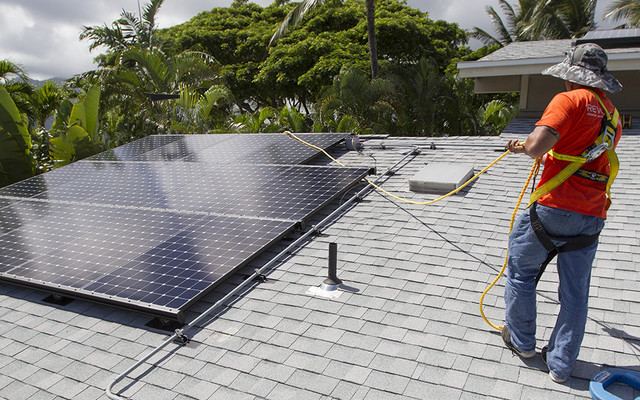The number of solar system permits issued by the City and County of Honolulu was up 14 percent in 2015 from the year before, while recent solar applications have declined after state regulators ended a popular solar incentive program.
In 2015 the City and County of Honolulu Department of Planning and Permitting issued 7,493 permits for solar electric systems, up from 6,554 issued in 2014, according to data from Marco Mangelsdorf, who tracks rooftop solar permits and is president of Hilo-based ProVision Solar.
Mangelsdorf said the year-over-year increase in permits is due to the rush of customers wanting to take advantage of a popular solar incentive program called Net Energy Metering. NEM credits solar owners with the full retail rate for the excess energy they send to the grid.
Hawaiian Electric Co. asked in January 2014 that the state change the program. In response to the utility’s application, state regulators ended the program in October and replaced it with two less attractive options. Because of this, the solar industry will see a slowdown, Mangelsdorf said.
“Once the accumulated fat of conditionally approved NEM systems is consumed, it’s gonna be grim,” Mangelsdorf said.
The programs replacing NEM are called “grid-supply” and “self-supply.” Customers who use grid-supply are credited approximately 15 cents per kilowatt-hour for the excess energy their systems send to the grid compared with the full retail rate, which this month is 23.8 cents per kilowatt-hour. Grid-supply has a minimum charge of $25 a month, while NEM has a minimum of $17.
As well as the lower credit, the grid-supply program also has a cap of approximately 4,500 residential systems. The solar industry said that the cap will likely be met sometime in 2016.
Under the self-supply program, solar customers do not export energy to the grid. Batteries linked to PV store the excess energy produced by solar systems. The Public Utilities Commission ordered that self-supply systems would be approved under an expedited review by HECO.
As of Jan. 5, 244 grid-supply applications were received for rooftop solar systems on Oahu. Of those not one has received approval for installation, according to Mangelsdorf. A total of 455 grid-supply packages have been submitted across the three Hawaiian Electric utilities.
Only one customer applied for a self-supply, or battery, system.
Mangelsdorf said he expects the number of grid-supply applicants to grow.
Chris DeBone, managing partner at Hawaii Energy Connection, said the low numbers were typical because sales are lower at the end of the year.
“I expect those numbers to grow per month,” DeBone said. “The fourth quarter or the last three months of the year are typically heavily install and low sales.”
DeBone said he still expects the industry to reach the cap on grid-supply systems around June. DeBone also said that it took a lot of time for solar salesmen to figure out customer savings after the PUC changed the program in October.
HECO leads the nation in the number of rooftop solar owners per customer served — approximately 16 percent of HECO’s customers on Oahu have rooftop solar.
On Oahu, 48,743 PV systems have been installed on residential homes. Combined, Hawaiian Electric Industries’ utility subsidiaries have more than 71,000 rooftop solar systems among 450,000 customers.

